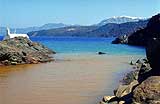
Geology of Santorini
- 3. volcanism -
3.1. Volcanism on Santorini / eruptive historyVolcanism in the area of Santorini (it was then only a small, non-volcanic island) started about 2 million years ago with the extrusion of dacitic lavas from vents in the area of the present-day Akrotiri peninsula and continued to produce different kinds of lavas and pyroclasts (Friedrich, 1994). However, the most characteristic type of activity over the last 200.000 years has been the cyclic construction of shield volcanoes interrupted by large explosive and destructive events like the Minoan eruption. In detail, the volcanic evolution of Santorini can be divided into six main stages (Druitt and others, 1989):
-> 3.1.1. Summary table of Volcanic eruption sequence on Santorini 3.1.2. Akrotiri Volcanoes and cinder cones (ca. 2000-500 ka) The oldest volcanic rocks are found on the Akrotiri peninsula and the Christiania islands. They are composed of dacitic lavas that updomed the sea floor and produced various flows and pyroclastic deposits. They have been strongly altered by hydrothermal activity. The updomed areas still are well visible on the Akrotiri peninsula (Lumaravi and Archangelos hills). From marine fossils embedded in the tuffs, Seidenkrantz and Friedrich (1992) concluded a minimum age for the Akrotiri peninsula of 2 million years. At this early stage the Akrotiri peninsula probably was a separate island and not yet connected to the non-volcanic island. 3.1.3. Peristeria and Thera Volcanoes (ca. 530-180 ka) Between 530 and 430 ka a large stratovolcano called Peristeria volcano formed in the north of the present caldera. The cinder cones on the Akrotiri peninsula are probably later products of these shields, too. Today, the remnants comprise most of Megalo Vouno and Mikro Profitis Ilias. At about 350-250 ka another shield volcano grew within the center of the present-day caldera, called Thera volcano. Some of its lava flows are visible at Cape Alai and Cape Alonaki near Fira. The formation of that shield united the former isolated centers and the limestone massif to a compact island. 3.1.4. First eruptive cycle (ca. 360-180 ka) Druitt and others (1989) recognized two cycles of large explosive eruptions with chemical transition from mafic to silicic lavas. The first one began with the Cape Therma 1 eruption, a thick scoria flow deposit in southern Thera, and includes the deposits of Cape Therma 2, Cape Therma 3. It terminated with the rhyodacitic and very prominent Lower Pumice 1 and 2 (BU1 and BU2) eruptions at about 200 and 180 ka. All of these were probably erupted from vents of the Thera Volcano. The first cycle concluded with caldera collapse and created the BU-caldera. Rests of this caldera can be seen at the cliffs below Fira where a discontinuity separates the BU2 deposits from the overlying layers. 3.1.5. Second eruptive cycle (ca. 180 ka - 1600 BC) and the northern lava shields The second cycle comprises at least 7 bigger eruptions: Cape Thera, Middle Pumice at 60 ka, Vourvoulos, Upper Scoriae 1 and 2 at circa 40 ka, Cape Riva at 21 ka and the Minoan eruption at ca. 1645 BC. Parallel to or preceding these eruptions different lava shields grew in the northern part of the caldera: Simandiri lavas at ca. 170 ka, the Skaros and the Therasia shields probably between 60 and 20 ka. --> 4.1.1. Models of the pre-Minoan island 3.1.6. The Kameni shield (197 BC - today) The formation of the post-Minoan Kameni islands, dacitic lava shields, is recorded by human observation and documented by historians. |
Copyright:
Before using text and photos of this page elsewhere please contact Tom Pfeiffer.
� Tom Pfeiffer, page last modified on 3 February 2004.